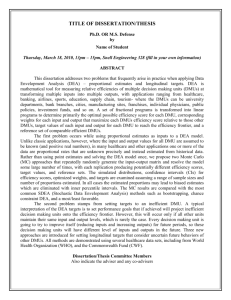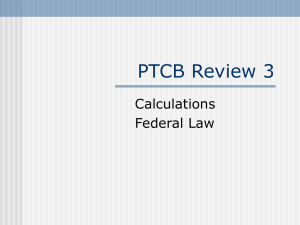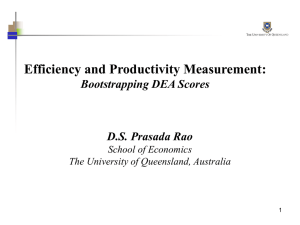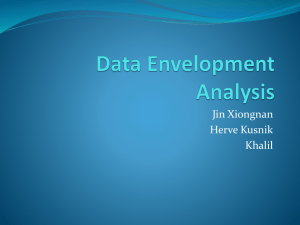5. conclusions
advertisement
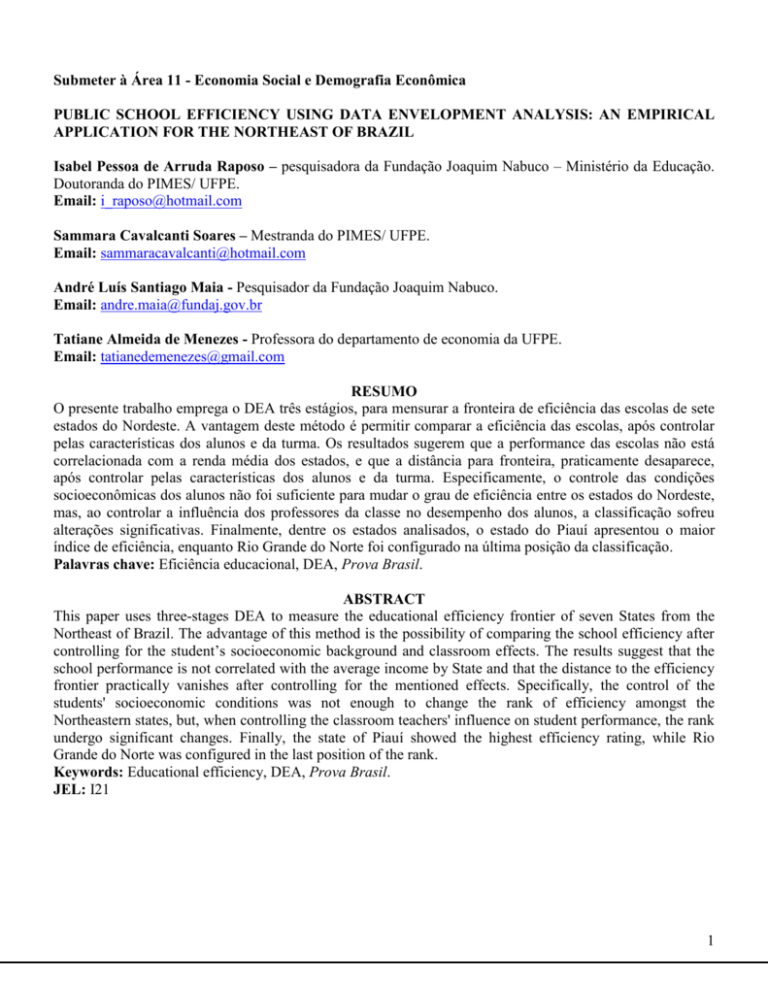
Submeter à Área 11 - Economia Social e Demografia Econômica PUBLIC SCHOOL EFFICIENCY USING DATA ENVELOPMENT ANALYSIS: AN EMPIRICAL APPLICATION FOR THE NORTHEAST OF BRAZIL Isabel Pessoa de Arruda Raposo – pesquisadora da Fundação Joaquim Nabuco – Ministério da Educação. Doutoranda do PIMES/ UFPE. Email: i_raposo@hotmail.com Sammara Cavalcanti Soares – Mestranda do PIMES/ UFPE. Email: sammaracavalcanti@hotmail.com André Luís Santiago Maia - Pesquisador da Fundação Joaquim Nabuco. Email: andre.maia@fundaj.gov.br Tatiane Almeida de Menezes - Professora do departamento de economia da UFPE. Email: tatianedemenezes@gmail.com RESUMO O presente trabalho emprega o DEA três estágios, para mensurar a fronteira de eficiência das escolas de sete estados do Nordeste. A vantagem deste método é permitir comparar a eficiência das escolas, após controlar pelas características dos alunos e da turma. Os resultados sugerem que a performance das escolas não está correlacionada com a renda média dos estados, e que a distância para fronteira, praticamente desaparece, após controlar pelas características dos alunos e da turma. Especificamente, o controle das condições socioeconômicas dos alunos não foi suficiente para mudar o grau de eficiência entre os estados do Nordeste, mas, ao controlar a influência dos professores da classe no desempenho dos alunos, a classificação sofreu alterações significativas. Finalmente, dentre os estados analisados, o estado do Piauí apresentou o maior índice de eficiência, enquanto Rio Grande do Norte foi configurado na última posição da classificação. Palavras chave: Eficiência educacional, DEA, Prova Brasil. ABSTRACT This paper uses three-stages DEA to measure the educational efficiency frontier of seven States from the Northeast of Brazil. The advantage of this method is the possibility of comparing the school efficiency after controlling for the student’s socioeconomic background and classroom effects. The results suggest that the school performance is not correlated with the average income by State and that the distance to the efficiency frontier practically vanishes after controlling for the mentioned effects. Specifically, the control of the students' socioeconomic conditions was not enough to change the rank of efficiency amongst the Northeastern states, but, when controlling the classroom teachers' influence on student performance, the rank undergo significant changes. Finally, the state of Piauí showed the highest efficiency rating, while Rio Grande do Norte was configured in the last position of the rank. Keywords: Educational efficiency, DEA, Prova Brasil. JEL: I21 1 PUBLIC SCHOOL EFFICIENCY USING DATA ENVELOPMENT ANALYSIS: AN EMPIRICAL APPLICATION FOR THE NORTHEAST OF BRAZIL RESUMO O presente trabalho emprega o DEA três estágios, para mensurar a fronteira de eficiência das escolas de sete estados do Nordeste. A vantagem deste método é permitir comparar a eficiência das escolas, após controlar pelas características dos alunos e da turma. Os resultados sugerem que a performance das escolas não está correlacionada com a renda média dos estados, e que a distância para fronteira, praticamente desaparece, após controlar pelas características dos alunos e da turma. Especificamente, o controle das condições socioeconômicas dos alunos não foi suficiente para mudar o grau de eficiência entre os estados do Nordeste, mas, ao controlar a influência dos professores da classe no desempenho dos alunos, a classificação sofreu alterações significativas. Finalmente, dentre os estados analisados, o estado do Piauí apresentou o maior índice de eficiência, enquanto Rio Grande do Norte foi configurado na última posição da classificação. Palavras chave: Eficiência educacional, DEA, Prova Brasil. ABSTRACT This paper uses three-stages DEA to measure the educational efficiency frontier of seven States from the Northeast of Brazil. The advantage of this method is the possibility of comparing the school efficiency after controlling for the student’s socioeconomic background and classroom effects. The results suggest that the school performance is not correlated with the average income by State and that the distance to the efficiency frontier practically vanishes after controlling for the mentioned effects. Specifically, the control of the students' socioeconomic conditions was not enough to change the rank of efficiency amongst the Northeastern states, but, when controlling the classroom teachers' influence on student performance, the rank undergo significant changes. Finally, the state of Piauí showed the highest efficiency rating, while Rio Grande do Norte was configured in the last position of the rank. Keywords: Educational efficiency, DEA, Prova Brasil. JEL: I21 1. INTRODUCTION Brazil’s education system has undergone profound changes in recent years and has achieved at least one significant advance: virtually universal access to basic education 1. Unfortunately, this expanded attendance has not been matched by improved quality. Much to the contrary: the performance of fourth and eighth-graders on the Basic Education Development Index (Índice de Desenvolvimento da Educação Básica or IDEB) has declined since 1995 and although there has been some improvement since 2003, the results in 2009 still fell short of those in 1995 (MEC/INEP, 2007 and 2009). The establishment of the National System to Evaluate Basic Education (Sistema Nacional de Avaliação da Educação Básica) in 1990, which gave rise to the current IDEB, has been a fundamental tool to monitor the quality of Brazilian education, by administering standardized achievement tests (Prova Brasil), besides providing a substantial volume of data on school practices and infrastructure, teachers’ characteristics and students’ socioeconomic background. This database is extremely valuable because it both provides data for research into the efficiency of the educational system and allows defining better public policies to address the problems identified. A school is considered efficient if its students can achieve a maximum academic result with a minimum use of scholar resources, ceteris paribus. The problem is that the efficiency of a teaching 1 The term basic education here corresponds to ensino fundamental, which covers the first through eighth grades. It is followed in the Brazilian scheme by ensino médio, or middle schooling, which covers ninth through eleventh grades, and then by ensino superior, or higher learning, meaning university or other specialized advanced study. In some places formal schooling starts with the curso de alfabetização, or literacy course (typically at the age of five years), which is roughly similar to kindergarten in the United States. High school graduation typically occurs at the age of 17 or 18. 2 establishment is not only affected by its resources or academic practices, it is also influenced by exogenous variables such as the student’s socioeconomic status and behavior as well as other environmental characteristics like various types of social infrastructure (provision of water, energy, sewerage, roads, safety, etc). As a result, the matter of efficiency can only be satisfactory explained if those exogenous variables can be properly separated from the effect of the school practices and resources. The purpose of this paper is to propose a methodology based on Data Envelopment Analysis (DEA) that addresses to this issue of efficiency using data from the public schools of the 4th grade of basic education level in the Northeast Region of Brazil. The article is organized into five sections including this introduction. In the next section we describe the method proposed to study school efficiency; in the third one we present the data utilized; the results are presented in the fourth section; and in the last one we make our concluding remarks. 2. USE OF DATA ENVELOPMENT ANALYSIS TO EVALUATE EDUCATIONAL EFFICIENCY The literature offers basically two lines of research into school performance: econometric studies, which seek to achieve static improvements to mitigate problems of endogeneity and distinguish the school effect; and studies that apply nonparametric techniques such as Data Envelopment Analysis to investigate questions related to school efficiency. This article proposes investigate educational efficiency by using a methodology based on Simar and Wilson (2007) work, but in an innovative fashion where the DEA estimation, differently from these authors, occurs on a third stage after cleaning out the influence of students characteristics and classroom effects on school efficiency. The DEA method has been applied to various areas of knowledge, such as production engineering, management and economics. In economics alone the applications include themes such as the efficiency of agriculture production (Gomes, 2008; Souza, 2002, cited in Souza & Wilhelm, 2009), public spending (Santos et al., 2007; Sampaio de Sousa & Stosic, 2005), health services (Marinho, 2001, cited in Faria & Januzzi, 2006), the energy sector (Laurencel & Souza, 2004; Câmara, 2008; Pires, 2008), quality of life (Sousa, 2007; Bezerra & Diwan, 2001, cited in Faria & Januzzi, 2006) and education (Delgado, 2007; Delgado & Machado, 2007; Braz, 2005; Wilson, 2005; Afonso & Aubyn, 2005, Façanha & Marinho, 2001, cited in Faria & Januzzi, 2006; Silva & Fernandes, 2001, cited in Faria & Januzzi, 2006). 2.1 The DEA Model DEA is a nonparametric technique that permits establishing the relative technical efficiency of decision making units (DMUs), each of which uses multiple inputs to produce one or more outputs. It permits identifying the efficiency of the school (DMU) based on the vector of its inputs (infrastructure, teacher qualification, etc.) available to achieve its main activity (achievement scores), permitting a varying combination of inputs to maximize efficiency, under the condition that the allocations of inputs in all the DMUs, do not consist of a single input. In this sense, it can be assumed that school administrators oriented to attain the highest efficiency will focus their choices mainly on the inputs that contribute the most to achieve its targets, and will focus less on those that have little effect on success. In the specialized literature, the first DEA model was developed by Charnes, Cooper & Rhodes (1978), and in homage to them it is also known as the CCR model. This model consists of determining for each DMU the maximum ratio between outputs and inputs, given the available inputs of each DMU. The efficiency frontier is then constructed based only on those DMUs that have achieved the maximum output for a given level of inputs, or that have consumed a minimum level of inputs to obtain a given amount of outputs. This construction is based on the best practices observed, since the efficiency frontier is formed from the DMUs that present, based on the observable data, the best performance in terms of the input-output ratio. Through the use of mathematical programming, the authors formulated this problem as follows: 3 m v x j 1 min f1 j j1 r y r1 s u r 1 m v x j ji s.t. j 1 s 1 (1) ur yri r 1 v j , ur 0 where f1 is the objective function of DMU 1 and i = 1, ..., n DMUs; x ji are the inputs of the i-th DMU; j = 1, ..., m; yri are the outputs of the i-th DMU; r = 1, ..., s; and ur and vj are the weights (weighting coefficients) determined by the solution of the problem. Note that the ith constraint in (1) expressed by the ratio m s v x u y j ji j 1 r ri ⁄ r 1 means that it is necessary at least a feasible input set X to produce a set of outputs Y. Equation (1) represents the fractional programming problem, which can be linearized to obtain the following linear programming model2: m min g1 v x j j1 j 1 s s.t. u r y r1 1 (2) r 1 m v x j 1 j s ji u r y ri 0 r 1 v j , ur 0 This is called the primal model, and for each one there is a dual formulation represented below by Equation (3). This way of composing the problem makes it simpler to resolve, by involving a smaller number of constraints (m+s < n+1), since it is advisable for the number of DMUs to be at least twice the number of variables. max f 1 n s.t.y r1 i y ri 0 (3) i 1 n x i 1 i ji x j1 i , 0 This model seeks to find the weights, , that maximize the final output given a limited amount of inputs for each of the n schools, as well as the values of , which represent the schools’ efficiency indices. The values of must be less than or equal to 1. When is equal to one, the DMU is considered efficient. 2 To better understand the mathematical developments, see the description provided in Charnes, Cooper & Rhodes (1978). 4 Thus, the efficiency frontier is formed by the set of points where = 1. A total of n problems of this type are resolved to construct the efficiency frontier. For each optimal solution found (f*) in each of the n objective functions, there is a * that expresses the distance of the DMU from the efficiency frontier. Hence, each inefficient DMU will have a reference for comparison (x*,y*), on the frontier, obtained from a linear combination of the DMUs, that is, based on the best practices. measures the distance of the point (x,y) of the inefficient DMU to the point (x*,y*) of the efficient DMU and hence expresses the rate of expansion of the outputs and inputs necessary for the DMU to become efficient. The CCR model imposes the following restrictions on the technology defining the efficiency frontier: (i) the existence of constant scale returns, (ii) strong disposability of inputs and outputs, and (iii) convexity of the set of feasible combinations of inputs and outputs. However, there is nothing that guarantees the exclusive existence of constant returns associated with a given technology. It is possible, for instance, for a technology to present variable returns, increasing for a determined level of output and constant or decreasing at other levels. The model developed by Banker, Charnes & Cooper (1984), also known as the BCC model, assumes this possibility and modifies the CCR model by inserting a new constraint, i , which guarantees convexity of the combination of reference DMUs. Many studies using DEA assume the existence of constant scale returns, where each increment in the set of inputs considered generates growth of equal magnitude on the output side. The problem with this hypothesis is that it might be true for one group of schools but not for another. It is possible that for some schools the students’ performance increases more than proportionally (increasing returns) or less than proportionally (non-increasing returns). To avoid this type of limitation, in this article we estimate the case of variable returns to scale in order to contemplate all the possible combinations. DEA method has two main limitations. The first is a possible inconsistency of the estimators, since because it is a nonparametric technique the convergence speed is slow and inconsistent s can be generated. The other restriction is related to the existence of outliers that can shift the efficiency frontier too much, thus placing many DMUs in the inefficiency region when they may in reality be efficient. To correct the problem of inconsistency of the estimators, the literature indicates the use of DEA estimation based on the bootstrap resampling scheme to eliminate bias, as proposed by Simar & Wilson (1998). The idea is based on the principle that to know the size of the bias it is necessary to obtain a 1 distribution of the efficiency estimators, i . Bootstrapping permits generating a sufficiently large series of estimates of i to obtain an empirical distribution that tends asymptotically to the true distribution of the i . With respect to the problem of outliers, a common practice in DEA (e. g., Santos et al., 2007; Delgado & Machado, 2007) is to utilize a procedure developed by Sampaio de Sousa & Stosic (2005), based on jackstrap and bootstrap. Here we treat the problem of inconsistency of the estimators through the bootstrap process proposed by Simar & Wilson (1998) and the question of identifying outlier DMUs by applying the procedure adopted by Sampaio de Sousa & Stosic (2005). It is important to remember that in correcting the bias by bootstrapping, the inconsistency biases are subtracted and for this reason the resulting values of i will be less than 1. 2.2 The three-stage model Most of the research done about efficiency typically applies the DEA method in two stages, where at the first stage, it is produced DEA’s efficiency estimates ( i ) and, then, in a second stage these estimates are regressed on other exogenous variables using a parametric model, either linear ordinary least squares or 5 censored tobit models (Aly et al 1990; Chirkos and Sears, 1994; Dietsch and Weill, 1999; Ray, 1991; Sexton et al, 1994; Stanton, 2002, cited in Simar and Wilson, 2007). One of the problems in a simple two-stage procedure is that the DEA’s estimates are by construction serially correlated, since a DMU is either efficient or it is related to at least another two DMUs placed on the efficient frontier (Delgado and Machado, 2007). The strategy suggested by Simar and Wilson (2007) to overcome such problem is the bootstrapping scheme to eliminate inconsistency bias. The present article also uses bootstrapping to correct for the serial correlation problem, however it proposes an alternative way to define an efficiency educational model, where the DEA technique is used in the third stage instead. On a typical two-stage procedure the goal is to find what are the environmental characteristics, including variables that aren’t under the school control, that can explain the educational efficiency. Here the goal is not to find which variables explain efficiency, but instead, to provide a rank of schools that is constructed using only the characteristics that are under the control of schools, independent of the socioeconomic and demographic status of students and independent of the class influence as well. The literature of education economics [Raudenbush and Willms, 1995; Barbosa and Fernandes, 2001; Soares, 2008] demonstrates that the student’s performance is basically influenced by three main sources: (i) school resources, (ii) student’s socioeconomic background and (iii) the classroom effect (peers and teacher’s influence). Therefore, given that efficiency here is being measured by the relationship between student’s grade and school resources, it is necessary to isolate effects (ii) and (iii) in the task of constructing the efficiency rank. On the first stage procedure, the goal is to control for the impact of quality of the student on school efficiency. The idea is that the influence of student’s background could be accounted for in a first stage OLS regression, such as: 𝑌𝑖 = 𝛽𝑍𝑖 + 𝜀𝑖 (4) where the dependent variable is the student’s math score in Prova Brasil and Z is the matrix of students academic behavior and socioeconomic and demographic status composed by the following variables: gender, age, race, mother’s years of school, father’s year of school, nº of people living in the household, n° of bathrooms in the household, student works, student works at home, n° of computers in the household, n° of books in the household, student went to kindergarten, student went to private school before, student failed before, student abandoned school before, student does math homework, student receives teacher’s compliment and parents incentive for studying. εi is the error term that presents the classic assumptions E(εi) = 0 and constant variance. Note that the predicted residuals of equation 4 capture all factors that explain students' math scores, but students' socioeconomic background. The second stage procedure is designed to control for the classroom teacher’s influence upon student’s grades. For this, it will be used the average residuals estimated from equation 4 by classroom as the dependent variable of the following model: 𝐸̂𝑗 = 𝜌𝑊𝑗 + 𝜖𝑗 (5) where Wj is the matrix of teacher’s attributes and academic behavior composed by the following variables: gender, age, race, years of school, years since graduated, wage, has another job, time since teaches the 4th grade, hours teaching the class, has permanent contract, % of course content taught, students received books. ϵi is the error term that presents the classic assumptions E(ϵj) = 0 and constant variance. The second stage predicted errors from (5) would capture all the variables that influence the student’s math grade but are not related to his or her socioeconomic status, neither with the classroom professor’s effect. The idea is to “clean” both the student’s socioeconomic factors and classroom teacher’s characteristics 6 influences on student’s learning process, as an attempt to isolate only the variables which are associated with the school inputs (teaching resources, total number of teacher in school, infrastructure, school practices and so on), therefore it is an appropriate variable to use as a DEA output. Finally, in the third stage procedure, the school efficiency is estimated using DEA method, where the average residuals from (5) by teaching establishment is the output variable and the input variables are only those resources that are directly under the school control. 3. DATA DESCRIPTION The results of the math grade in Prova Brasil given to students in the fourth grade in 2007 and those of 2006 School Census compose the database used in this article to estimate the school efficiency frontier of the public schools in the Northeast region of Brazil. The School Census gathers data on schools’ physical characteristics, number of students enrolled, faculty characteristics and grade progression. In turn, the Prova Brasil measures school achievement in mathematics and Portuguese. The Prova Brasil is a census exam that evaluates students` performances in Portuguese and mathematics on elementary education (4th and 8th grades) from all urban public schools in Brazil3. Through questionnaires applied along with the exams, it is possible to collect students’ information about social, economic and cultural contexts as well as their school history. Teachers and principals also answer the questionnaires, which make it possible to know the professional formation, teaching practices, socioeconomic and cultural levels, leadership styles and ways of management. Information about academic and discipline climate, available learning resources, infrastructure and school’s human resources are also included in data collection. The total sample used to estimate the efficiency frontier was composed of 862 schools for seven Brazilian Northeast States. The missing and zero values were eliminated from the sample4. Table 1 below shows the distribution of the used sample by type of school and state. Table 1 Sample of schools with 4th graders taking the Prova Brasil by type – states of Northeast of Brazil States State School Municipal School Total Alagoas 25 37 62 Maranhão 55 44 99 Paraíba 66 111 177 Pernambuco 138 116 254 Piauí 45 46 91 Rio Grande do Norte 55 64 119 Sergipe 32 28 60 Northeast Region 416 446 862 Source: School Census and Prova Brasil – MEC/INEP, 2006 and 2007. The input and output variables of the DEA model are described in the table 2. Some of the variables presented in this Table that compose the set of school inputs were constructed by principal component analysis. The construction of synthetic indicators provides an analytical instrument that permits formulating a diagnosis whereby diverse school infrastructure variables are evaluated together, preserving their statistical interrelationships. In this study we constructed seven school indicators from the PCA technique: administrative spaces, building infrastructure, educational spaces, meal facilities, basic infrastructure, teaching equipment, and sportive spaces. We eliminated the variables that had a correlation greater than or 3 4 For schools which have more than 30 students per class. The states of Bahia and Ceará hadn´t enough information, so we had to exclude them of analysis. 7 equal to 0.40 with more than one component (variables with complex structure), as well as the variables whose derived components explained less than 50% of each variable’s variance. We also applied: (i) the Kaiser-Meyer-Olkin (KMO) test of sampling adequacy, which assesses the proportion of the variance of the data common to the variables under analysis that can be attributed to a common factor, and (ii) the Bartlett test of sphericity, which tests the hypothesis that the correlation matrix of the variables is not an identity matrix, which in this case would indicate the variables are not correlated, making it impossible to apply the PCA technique. If the significance in the sphericity tends to zero and the KMO test indicates a value greater than 0.5, then the use of PCA is adequate and can be useful to reduce the variables into components. 8 Variable Table 2 Descriptive statistics of the schools - Northeast Mean SD Minimum Maximum Total number of non-teaching staff Total number of teachers Number of classrooms 64.40 35.92 12.93 Percentage of teachers with teaching credentials 0.31 teaching in the 1st to 4th grades Number of public educational programs the 3.40 school participates Indicator of administrative spaces1 2.19 Indicator of building infrastructure2 2.02 3 0.79 Indicator of educational spaces Indicator of meal facilities4 1.32 5 2.36 Indicator of basic infrastructure Indicator of teaching equipment6 1.06 0.63 Indicator of sportive spaces7 Hours students remained at school 368.35 8 3.10 Principal's years of school 9 2.19 Years since last graduation of the Principal 6.73 Principal's salary 10 2.19 Years as school Principal 11 3.27 Principal's hours worked th Average math score of 4 graders (output – 176.97 Model 1) Average residuals from eq. (4) (output – Model 2) 182.52 Average residuals from eq. (5) (output – Model 3) 182.03 31.66 18.30 5.99 8 5 2 395 188 62 0.25 0 1 1.52 1 10 0.43 0.53 0.44 0.41 0.42 0.78 0.19 81.96 1.25 1.10 2.75 1.10 0.70 1 1 0 0 1 0 1 90 1 1 1 1 1 2 7 3 2 3 8 2 730 5 5 13 5 4 14.37 124.35 245.18 7.35 1.46 148.65 176.12 209.20 185.97 Source: School Census and Prova Brasil – MEC/INEP, 2006 and 2007. 1) Principal’s office, secretary’s office, teachers’ lounge 2) Some schools do not have their own building, meaning that they operate in other institutions spaces, such as granted rooms from churches, gymnasium or private owners. The indicator was built based on the following variables: the school has its own building, has bathroom inside the building, has drinking fountain, classrooms have air-conditioned or ventilator; 3) Library; reading room; informatics or science labs; videoteque; video and TV rooms; auditorium. 4) Kitchen, cafeteria, stove, food scale; 5) School has public provision of energy, water and garbage collection; 6) Total number of computers and printers, TV, rear projector; 7) Gymnasium and swimming pool. 8) 1- high school completed; 2-college completed; 3-especialization; 4-master; 5- doctorate 9) 1 – two (or less) years; 2- from 3 to 7 years; 3- from 8 to 14 years; 4-from 15 to 20 years; 5-more than 20 years college graduated 10) 1- less than two years; 2 – from 2 to 4 years; 3-from 5 to 10 years; 4-from 11 to 15 years; 5- more than 15 years 11) 1 – up to 20 hours per week; 2- up to 30 hours per week; 3- up to 40 hrs per week; 4- more than 40 hrs The descriptive statistics of the school inputs used on the model show that on average, the sportive spaces loses in size for administrative and educational spaces of the school. The average time that students spend in school is 4 hours, but varies greatly, according to the maximum and minimum values displayed; the 9 indicator representing the director's salary, of 6.7, means that his salary is around $ 1200 on average. Still, we find that the average math score of the student is 177 points, below the minimum required by the Brazilian Ministry of Education of 200 points for the 4th grade. Table 3 bellow presents the chosen variables that will be used to socioeconomic control in equation 4. They are supported by the extensive national and international literatures about the characteristics of the students and their background. Table 3 Descriptive statistics of the student´s socioeconomic status (equation 4) Variable Mean SD Minimum Maximum gender (male =1) race (white =1) Age1 mother´s years of school2 father´s years of school3 # of people living in hh # of bathroom student works # of hours student works at home # of computer in hh # of books of hh4 Kindergarten private school frequency failed5 frequency abandoned school6 frequency of math homework7 frequency of teacher compliment8 parents incentive Average math score of 4th graders 0.50 0.28 4.02 2.79 2.80 3.96 1.32 0.17 0.50 0.45 1.36 1.31 1.37 1.06 0.67 0.37 0 0 1 1 1 1 0 0 1 1 8 5 5 6 4 1 1.49 0.19 1.35 0.72 0.20 0.50 0.11 2.76 1.20 0.39 0.81 0.45 0.40 0.68 0.37 0.56 0 0 0 0 0 0 0 0 4 1 3 1 1 2 2 3 1.69 0.96 0.56 0.20 0 0 2 1 176.97 14.37 124.35 245.18 Source: School Census and Prova Brasil – MEC/INEP, 2006 and 2007. 1) 1(mín)- 8 years old or less; 8 (max)- 15 years old; the avarege is 11 years old 2) 1-no years of school; 2-elementar school not completed; 3-elementar school completed; 4-high school completed; 5-college completed 3) 1-no years of school; 2-elementar school not completed; 3-elementar school completed; 4-high school completed; 5-college completed 4) 0-no books at home; 1-between 21 to 100 books; 3- more than 100 books 5) 0- never failed; 1-failed once; 2- failed twice or more 6) 0- never failed; 1-failed once; 2- failed twice or more 7) 0 – the teacher do not ask for homework; 1- the student do not do the homework almost never; 2- sometimes; 3- always 8) 0 –never; 1-sometimes; 2-always or almost always Table 4 presents the variables that will be used to control for the classroom teacher’s effect in equation 5. 10 Table 4 Descriptive statistics of the classroom’s teachers - regression variables 2nd stage (equation 5) Variable Mean S.D Minimum Maximum age gender (male=1) race (white=1) years of school1 years since graduate2 Wage3 has another job time since teaches the 4th grade4 hours worked5 Permanent contract % of course content taught6 class has received books 3.65 0.09 0.31 2.78 2.59 3.74 0.47 1.08 0.27 0.45 0.41 1.27 2.04 0.49 1 0 0 1 1 1 0 6 1 1 3 5 13 1 3.09 5.60 0.81 2.86 3.39 1.62 2.74 0.38 0.75 1.11 1 1 0 1 0 5 11 1 4 4 Source: School Census and Prova Brasil – MEC/INEP, 2006 and 2007. 1) 1 – less than high school; 2- high school completed; 3-college completed 2) –1 – two (or less) years; 2- from 3 to 7 years; 3- from 8 to 14 years; 4-from 15 to 20 years; 5-more than 20 years college graduated 3) 1- R$380 reais salary; 13 – more than R$ 3.100 salary ; the resulto of average salary was R$700,00 reais 4) 1- up to 2 years; 2- from 2 to 4 years; 3- from 5 to 6 years; 4 - from 7 to 8 years; 5- 9 or more years teaching on 4th grade 5) 1- less than 16 hrs-class; 2 – more than 40 hrs-class; the 5.6 time average corresponded between 25 and 29 hrs-class 6) 1- less than 40%; 2 –between 40% and 60%; 3 – between 60% and 80%; 4 – more than 80%. 4. EDUCATIONAL EFFICIENCY RESULTS OF THE SCHOOLS Three different types of models were estimated. Model 1 was the one-stage DEA using math score as output variable, Model 2 was the two-stage DEA, using the residuals from (4) as output and Model 3, the three-stage DEA using the residuals from (5) as output. The estimations were carried out with the statistical package developed by Wilson (2006) and executed with R, called FEAR (Frontier Efficiency Analysis with R). Following Sampaio de Sousa & Stosic (2005) outlier schools were removed for every model estimated. After that DEA was estimated again with bias correction through bootstrap to resolve the problem of inconsistency of the estimators. This correction was done according to Simar & Wilson (1998) with 1 thousand repetitions. In this procedure, the estimated efficiency parameter of each school was subtracted in the magnitude of the bias obtained by this technique, so that the maximum efficiency value was always less than 1. The first results are presented in Figure 1 that exhibits the average estimated efficiency by State for the Model 1. In this model the output variable was the average math grade by school and the inputs all the school resources presented in Tables 2 and 45. In spite of the fact that Piauí and Maranhão are the poorest States in Northeast they presented the most efficient school, as illustrated in the Figure. It is important to mention that these two States have more than 40% of the school age population (5 to 14 years old) living in rural areas, while in the other States this percentage reduces to somewhere around 25% (IBGE, 2000). Since Note that the classroom teacher’s characteristics enter as input resources in Model 1, since in this Model the output variable is not yet controlled for the classroom teacher’s influence. 5 11 the Prova Brazil applies only to urban educational establishments and the poverty concentrates in the rural zones, it is possible that there is a higher demand for school enrollment in those units that presented higher urban concentration, which can create a burden on educational equipments and, thus, reduce efficiency. Figure 1 The Average School Efficiency by the Northeast States of Brazil – Model 1 DEA - Model 1 0.950 0.941 0.935 0.940 0.933 0.930 0.930 0.917 0.920 0.903 0.910 0.898 0.900 0.890 0.880 0.870 PI MA AL PB SE PE RN Source: Authors, based on data from School Census and Prova Brasil – MEC/INEP, 2006 and 2007. As exhaustively discussed in the literature (Coleman, 1966; Ferrão and Fernandes,2005; Barros et.al. 2001), the school efficiency might also be influenced by the student and family’s characteristics as well. In order to control for such problem, this paper estimated a two-stage DEA (Model 2), using the same input variables as Model 1 and the residuals from equation 4 as the output variable. The first stage estimation of equation 4 is presented in Table 5. This result suggests that around 10 % of the math score can be explained by student and families’ characteristics (R2=0.10). As expected most of the independent variables were significant and presented the correct sign. 12 Table 5 OLS regression with math score as dependent variable Coef. Std. Err. P>t gender (male =1) race (white =1) age mother´s years of school father´s years of school # of people living in hh # of bathroom student works # of hours student works at home # of computer in hh # of books of hh kindergarten private school frequency failed frequency abandoned school frequency of math homework frequency of teacher compliment parents incentive _cons R2 F( 18, 15322) Prob > F Obs. 4.62 -3.22 -1.34 1.36 0.64 -2.60 1.88 -10.02 -3.29 -2.34 0.33 4.23 5.94 -6.19 -0.58 6.41 -0.63 10.90 167.26 0.10 98.74 0 15341 0.62 0.66 0.27 0.27 0.25 0.28 0.48 0.82 0.25 0.84 0.38 0.64 0.79 0.52 0.84 0.51 0.53 1.40 2.69 0.00 0.00 0.00 0.00 0.01 0.00 0.00 0.00 0.00 0.01 0.38 0.00 0.00 0.00 0.49 0.00 0.24 0.00 0.00 Source: Authors, based on data from School Census and Prova Brasil – MEC/INEP, 2006 and 2007. Figure 2 brings the results of average efficiency by State for the Model 2. The results are very similar to Model 1, except for a reversal in the rank position between the States of Pernambuco and Sergipe. This finding suggests that even after controlling for the socioeconomic characteristics of the students the school efficiency does not change significantly. 13 Figure 2 The Average School Efficiency by the Northeast States of Brazil – Model 2 DEA - Model 2 0.979 0.9800 0.978 0.974 0.9750 0.974 0.9700 0.966 0.964 0.9650 0.963 0.9600 0.9550 0.9500 PI MA AL PB SE PE RN Source: Authors, based on data from School Census and Prova Brasil – MEC/INEP, 2006 and 2007. Finally the third-stage DEA is estimated (Model 3). As already mentioned, besides controlling for the student’s background (Model 2), it is also necessary to isolate for the effect of the professors. This is carried out in a three-stage DEA procedure, using the input variables from Table 2 and the residuals from equation 5 as the output variable. The estimation of equation 5 is presented in Table 6. Even though some variables were not significant, the model presented joint significance (Prob>F = 0) and this was sufficient since we are interested only in the residuals. The independent variables that were significant presented the correct sign. 14 OLS regression with 1st Table 6 stage average residuals by classroom as dependent variable Coef. Std. Err. P>t teacher’s age teacher’s gender (male=1) teacher’s race (white=1) teacher’s years of school years since teacher graduated teacher’s wage teacher has another job time since teaches the class hours worked in class teacher has permanent contract % of course content taught class has received books _cons R2 F( 12, 2067) Prob > F Obs. 0.17 -2.45 0.05 0.39 0.08 0.18 0.34 0.14 0.00 -0.90 1.29 0.50 174.41 0.04 6.41 0 2080 0.19 0.68 0.37 0.51 0.18 0.10 0.35 0.11 0.06 0.50 0.23 0.17 1.79 0.37 0.00 0.88 0.44 0.64 0.07 0.33 0.22 0.95 0.08 0.00 0.00 0.00 Source: Authors, based on data from School Census and Prova Brasil – MEC/INEP, 2006 and 2007. The average math score and residuals by schools from 1st and 2nd stage are plotted in Figure 3. Series are somehow correlated but the residuals variances, especially in the 2nd stage, are smoother then the math score variance. 15 Figure 3 Math score and residuals – Northeast States of Brazil 260.00 240.00 220.00 200.00 180.00 160.00 140.00 120.00 math score 1ststage_residuals 2ndstage_residuals Source: Authors, based on data from School Census and Prova Brasil – MEC/INEP, 2006 and 2007. Have been estimated the three different models, we now present a comparison among them in Table 7. Note that after controlling for the student´s background and the classroom effect, the estimated efficiency becomes much more homogenous among schools, as one can see comparing the standard deviation of Model 3 with those of Models 1 and 2. For extreme cases, as Pernambuco State, the standard deviation of Model 1 is about 12 times greater than Model 3. These findings suggest that the school performance is not correlated with the average income by State and that the distance to the efficiency frontier practically vanishes after controlling for the student’s socioeconomics characteristics and classroom influences. Another interesting aspect of these results is that the ranks of efficiency among States remain basically the same after controlling for student’s background only (Model 1 versus 2), but it changes after controlling for the classroom effect as well (Model 1 versus 3). This result is important and means that the classroom teacher’s influence is playing a significant role on student’s performance. The efficiency ranks change for most of the States according to models, except Piauí and Rio Grande do Norte. The States of Paraíba and Pernambuco increase positions in the rank, while the opposite occurs for the States of Alagoas, Sergipe and Maranhão. In other words, those states whose scholar efficiency ranks were changed, were more susceptible to the classroom effects in their efficiency attainment and therefore the improvement of educational quality seems to be more dependent on investments in the docent qualification. 16 Table 7 Efficiency results according to models – Northeast States of Brazil Variable PI MA AL PB SE PE RN DEA - Model 1 0.941 0.935 0.933 0.930 0.917 0.903 0.898 SD DEA 1 0.024 0.036 0.031 0.036 0.056 0.071 0.075 Rank DEA 1 1 2 3 4 5 6 7 DEA - Model 2 0.979 0.978 0.974 0.974 0.964 0.966 0.963 SD DEA 2 0.011 0.013 0.018 0.019 0.027 0.025 0.030 Rank DEA 2 1 2 3 4 6 5 7 SD DEA 1/ SD DEA 2 2.13 2.82 1.72 1.91 2.06 2.79 2.48 DEA - Model 3 0.9921 0.9908 0.9892 0.9918 0.9892 0.9895 0.9877 SD DEA 3 0.0046 0.0056 0.0059 0.0043 0.0055 0.0057 0.0065 Rank DEA 3 1 3 5 2 6 4 7 SD DEA 2/ SD DEA 3 2.50 2.30 3.04 4.39 4.97 4.42 4.67 SD DEA 1/ SD DEA 3 5.32 6.50 5.23 8.40 10.25 12.32 11.57 Rank1-Rank3 0 -1 -2 2 -1 2 0 Source: Authors, based on data from School Census and Prova Brasil – MEC/INEP, 2006 and 2007. 5. CONCLUSIONS The student’s cognitive performance, measured by his/her standardized tests proficiency, is a result of personal choices, of socioeconomic antecedents, of family structure and values, of the society in which he/she lives in, and, finally, the school in which he/she studies (ANDRADE E SOARES, 2008). Since the school is ultimately the target of educational public policies interventions, it is useful to understand the school’s influence on the student’s performance after socioeconomic control. Given the very weak performance in Prova Brasil of the basic public school students, this paper has proposed to analyze the role of school on such outcome. The idea was to understand this role in terms of efficiency, that is, how the school could use its resources in a way to maximize the student’s performance in achievement tests. In order to construct a rank of educational efficiency, this paper adopted an innovative three-stage DEA procedure and applied it to the public schools in the Brazilian Northeast who had 4th graders assessed by the Prova Brasil in 2007. The results showed that after controlling for the student´s socioeconomic variables and teacher’s effect, the estimated efficiency became much more homogenous among schools, meaning that the school performance seems not to be correlated with the average income by State. Piauí and Paraíba States presented the highest average efficiency while Rio Grande do Norte and Sergipe were relatively less efficient. Also, the rank of efficiency did not change substantially after controlling for the student’s socioeconomic background. However, changes were found when additional control for the teachers' effect was implemented, as well. This result was important and meant that the teacher influence was playing a significant role on student’s performance. As a conclusion, it can be said that those states whose scholar efficiency ranks were altered (all of them except Piauí and Rio Grande do Norte), were more susceptible to the teachers' effects in their efficiency attainment and therefore the improvement of educational quality seems to be more dependent on investments in the docent qualification. 17 REFERENCES AFONSO, A. AUBYN, M. S. Cross-country efficiency of secondary education provision: A semi-parametric analysis with nondiscretionary inputs. European Central Bank - Working Paper Series, no. 494, June 2005. BARBOSA, M.E.F, FERNANDES, C. A escola brasileira faz diferença? Uma investigação dos efeitos da escola na proficiência em matemática dos alunos da 4ª série. In: FRANCO, C. (Org.) Avaliação, ciclos e promoção na educação. Porto Alegre: ARTMED, 2001. BANKER, R.; CHARNES, A.; COOPER, W. W. Some models for estimating technical and scale inefficiencies in data envelopment analysis. Management Science, v. 30, n. 9, pp. 1078-1092, Sept. 1984. BARROS, R. et al. Determinantes do Desempenho Educacional no Brasil, IPEA, Rio de Janeiro, texto para discussão 834, 2001. BEZERRA, E. P. G. DIWAN, J. R. Uso de DEA como alternativa ao IDH na mensuração do desenvolvimento humano nos maiores municípios brasileiros. Undergraduate Monograph in Production Engineering. UFRJ, Rio de Janeiro, 2001. BRAZ, G. F. Aplicação de um método quantitativo e comparado, a análise de envoltória de dados (DEA), para avaliação do desempenho dos departamentos acadêmicos da Universidade State School de Montes Claros. Master’s Dissertation in Production Engineering, UFMG, Belo Horizonte, 2005. C. A. K.; SCHIMDT, P. (Eds.). The measurement of productive efficiency: Techniques and applications. Oxford: Oxford University, pp. 68-119, 1993. CÂMARA, E. A. Um estudo comparativo da eficiência das usinas hidrelétricas do Brasil, utilizando a análise por envoltória de dados – DEA. Master’s Dissertation in Economics, UFPE, Recife, 2008. CHARNES A.; COOPER, W. W.; RHODES, E. Measuring the efficiency of decision making units. European Journal of Operational Research, v. 2, n. 6, pp. 429-444, 1978. CRIBARI-NETO, F. & ZARKOS, S. Leverage-adjusted heteroskedastic bootstrap methods. Journal of Statistical Computational and Simulation, 74, pp. 215-232. 2004 COLEMAN, J.S. et al. Equality of Educational Opportunity, Washington, Office of Education, U.S. Department of Health, Education and Welfare, 1966. DELGADO, V. M. S. Eficiência das escolas públicas de Minas Gerais: considerações acerca da qualidade a partir da análise dos dados do SICA e SIMAVE. Master’s Dissertation in Economics, UFMG, Belo Horizonte, 2007. DELGADO, V. M. S.; MACHADO, A. F. Eficiência das escolas públicas estaduais de Minas Gerais. Pesquisa e Planejamento Econômico (PPE-IPEA), v.37, n. 3, pp. 427-464. Available at: http://ppe.ipea.gov.br/index.php/ppe/article/viewFile/1054/1017, 2007. FARIA, A. F.; JANUZZI, P. M. Eficiência dos gastos municipais em saúde e educação: uma investigação através da análise envoltória no Estado do Rio de Janeiro. Rio de Janeiro: IPEA, 2006. FAÇANHA, L.; MARINHO, A. Instituições de ensino superior governamentais e particulares: avaliação comparativa de eficiência. Rio de Janeiro: IPEA, 2001 (Text for discussion n. 813). FERNANDES, R. Índice de Desenvolvimento da Educação Básica (IDEB). INEP/MEC – Instituto Nacional de Estudos e Pesquisas Educacionais Anísio Teixeira. Brasília. Available at: http://www.publicacoes.inep.gov.br/arquivos/%7B9C976990-7D8D-4610-AA7CFF0B82DBAE97%7D_Texto_para_discussão26.pdf, 2007. FERRÃO, M. E. & FERNANDES, C. (2003). O efeito escola e a mudança – dá para mudar? Evidencias da investigação brasileira. Revista Eletrônica Ibero-americana sobre Qualidade, Eficácia e Mudança em Educação (REICE), 1(1), 1-13. GOMES, E. G. Uso de modelos DEA em agricultura: revisão da literatura, ENGEVISTA v. 10, n. 1, p. 2751, UFF, RJ, 2008. 18 GREENE, W. The econometric approach to efficiency analysis. In: FRIED, H.; LOVELL, C. A. K.; SCHIMDT, P. (Eds.). The measurement of productive efficiency: Techniques and applications. Oxford: Oxford University, pp. 68-119, 1993. IBGE. Síntese de indicadores sociais: uma análise das condições de vida da população brasileira; 2007. Rio de Janeiro, IBGE/DEPIS/COPIS, 2007. LAURENCEL, L. C; SOUZA, R. C. Usando DEA na avaliação da eficiência operacional das distribuidoras do setor elétrico brasileiro. In: XII Congreso Latino-Iberoamericano de Investigación de Operaciones y Sistemas, 2004, Havana. MARINHO, A. Avaliação da eficiência técnica nos serviços de saúde dos municípios do estado do Rio de Janeiro. Text for discussion no. 842: IPEA. Rio de Janeiro, 2001. MINISTÉRIO DA EDUCAÇÃO – MEC / INSTITUTO NACIONAL DE ESTUDOS E PESQUISAS EDUCACIONAIS ANÍSIO TEIXEIRA – INEP. School Census da Educação Básica- 2006: sinopse estatística. Brasília; MEC/INEP, 2006. MINISTÉRIO DA EDUCAÇÃO – MEC / INSTITUTO NACIONAL DE ESTUDOS E PESQUISAS EDUCACIONAIS ANÍSIO TEIXEIRA – INEP. SAEB – 2005 Primeiros Resultados: Means de desempenho do SAEB/2005 em perspectiva comparada. Brasília, 2007. Available at: http://www.inep.gov.br/salas/download/prova_brasil/Resultados/Saeb_resultados95_05_UF.pdf. MINISTÉRIO DA EDUCAÇÃO – MEC / INSTITUTO NACIONAL DE ESTUDOS E PESQUISAS EDUCACIONAIS ANÍSIO TEIXEIRA – INEP. Ensino Fundamental Regular - Séries Iniciais e Finais. Taxa de Aprovação, Prova Brasil, IDEB e Projeções - Regiões Geográficas e Unidades da Federação, 2005, 2007 e 2009. Available at: http://portalideb.inep.gov.br/index.php?option=com_content&task=view&id=6&Itemid=6. Visto em 12/7/2010. PIRES, M. A. A. Análise da evolução da eficiência das empresas distribuidoras de energia elétrica no Brasil, após a reestruturação do setor, no período de 2001 a 2005. Master’s Dissertation in Economics, UFPE, Recife, 2008. RAUDENBUSH, S. W.; BRYK, A. S. Hierarchical linear models. Thousand Oaks: Sage, 2002 SAMPAIO DE SOUSA, M. C.; STOSIC, B. Technical efficiency of the Brazilian municipalities: Correcting nonparametric frontier measurements for outliers. Journal of Productivity Analysis, v. 24, n. 2, pp. 157-181, 2005. SANTOS, F. C. B.; CRIBARI-NETO, F.; SAMPAIO DE SOUSA, M. C. Uma avaliação da eficiência do gasto público municipal no Brasil. Revista Brasileira de Estatística (IBGE), Rio de Janeiro, v. 68, n. 228, pp. 7-55, Jan-June 2007. SILVA, M. M; FERNANDES, E. Um estudo da eficiência dos programas de pós-graduação em engenharia no Brasil. In: Avaliação. Revista Rede Avaliação Instituição da Educação Superior. 2001, year 6, v. 6, n. 3 (21), pp. 53-66. SIMAR, L.; WILSON, P. W. Sensitivity analysis of efficiency scores: How to bootstrap in nonparametric frontier models. Management Science, v. 44, n. 1, pp. 46-61, Jan. 1998. SIMAR, L.; WILSON, P. W. Estimation and inference in two-stage, semi-parametric models of production processes. Journal of Econometrics, v. 136, pp. 31-64, 2007. SOUSA, L. Aplicação de data envelopment analysis – DEA para obtenção de mapas de exclusão e inclusão social. Master’s Dissertation in Biometry, UFRPE, Recife, 2007. SOUZA, P. C. T. Uma metodologia baseada em DEA para avaliação da eficiência técnica de produtores de leite. Master’s Dissertation in Numerical Methods in Engineering, UFPR - PR, 2002. SOARES, J. e ANDRADE, R., O efeito da escola básica brasileira. Estudos em Avaliação Educacional v.19 n. 41, 2008 SOUZA, P. C. T. WILHELM, V. E. Uma introdução aos modelos DEA de eficiência técnica. Tuiuti: Ciência e Cultura, n. 42, pp. 121-139, Curitiba, 2009. 19 WILSON, P. W. Efficiency in Education Production among PISA Countries, with Emphasis on Transitioning Economies. Department of Economics - University of Texas, 2005. Mimeo. WILSON, P. W. FEAR: A Software Package for Frontier Efficiency Analysis with R. December 2006. Available at: http://www.clemson.edu/economics/faculty/wilson/Software/FEAR/paper/fear.pdf. 20
